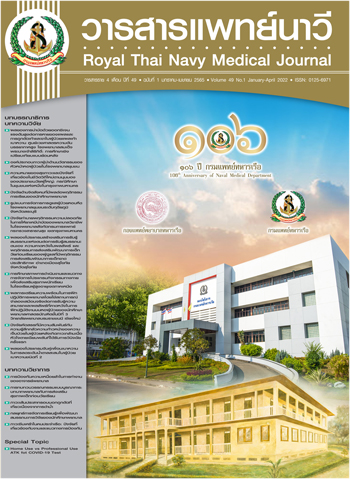The Study of Operating Conditions and Guidelines of Physical Activity Program Management for Promoting Students’ Health in the Northern Elderly Schools
Main Article Content
Abstract
This research aimed to study the operating conditions and guidelines for the management of physical activity programs to promote the health of students in elderly school. This study divided into 2 steps. Step 1 was the study of operating conditions. It consisted of a total of 388 people from 23 senior school committees. Step 2 was a study on the management of physical activity programs to promote students’ health in elderly school. The subject consisted of 16 people, from the School Board for Older Persons from Plai Chumpon School, Plai Chumpon Subdistrict Municipality, Phitsanulok province. The tools used for data collection consisted of questionnaires and group interview forms. The data were analyzed using percentage, mean, standard deviation, and content analysis
The results showed that the physical activity program management promotes students’ health in elderly schools. Management principles (POLE) were Planning, Organizing, Leading, and Evaluating, resource management, and the organization of elderly students’ physical activities with participation. There was a high level of management condition (M = 3.58, SD = 0.47) and the physical activity program for elderly students management conditions are at a moderate level (M = 2.88, SD = 0.40). In addition, findings of this study showed that the guidelines for the management of the physical activities program to promote the health of students in the senior school should be consisted of 1) management resources, which were personnel, budget, materials, equipment, and place 2) physical activity program to promote students’ health 3) physical activity organization for elderly students with participation 4) management process, including planning, organizing, leading, and evaluating. In conclusion, the findings showed that the physical activity programs could be applied consistently in the context of each area by means of increasing the role of the local organization and the physical activity leader development. It will also benefit elderly schools in applying the research results on the management of physical activity programs for promoting students’ health.
Article Details

This work is licensed under a Creative Commons Attribution-NonCommercial-NoDerivatives 4.0 International License.
References
Statistical Forecasting Bureau, National Statistical Office. The 2014 survey of the older persons in Thailand. Bangkok: Text and Journal Publication; 2014. (in Thai).
Department of Older Persons and the Ministry of Social Development and Human Security. School Handbook for the Elderly 2016. [Internet]. [cited 2020 September 16 ]. Available from: https://www.dop.go.th/th/know/5/24. (in Thai).
Arsantia J, Pomthong R. Trends in care of the elderly in the 21st century: challenges in nursing. Journal of the Royal Thai Army Nurses 2018;19(1):40. (in Thai).
Ministry of Tourism and Sports. National sports development plan No. 6 (2017 - 2021) Bangkok: Office of the Veterans Organization Printing House; 2017. (in Thai).
Webber SC, Porter MM, Menec VH. Mobility in older adults: a comprehensive framework; Gerontologist 2010;50(4):443-50.
Nakorn K, Purakom, A. International movement: principles and guidelines for organizing physical activities for health. Journal of Health Education, Physical Education and Recreation 2011;37(3):71-6. (in Thai).
The Committee Drafted a Master Plan for the Promotion of Physical Activities. Master plan to promote physical activities 2018 - 2030. [Internet]. [cited 2020 July 19]. Available from: https://planning.anamai.moph.go.th/download/D_DataMarts/PH_ACT/Master-Plan-for-Promoting-National-Physical-Activity.pdf. (in Thai).
Department of Elderly Affairs. Handbook of the elderly school 2016. Bangkok: Ministry of Social Development and Human Security; 2016. (in Thai).
Soponthamrak A. The seniors' school turns old people into social power. Thai Post [Internet]. 2018 January 29. [cited 2018 November 24]. Available from: http://www.thaihealth.or.th/Content/40528- Senior School% 20 turn the old man% 20 into a social force. html. (in Thai).
Khruthakul K. Handbook for the promotion of physical activity and physical fitness promotion of the elderly (Officer and caretaker version). Mahidol University; 2018. [Internet]. [cited 2020 August 12]. Available from: https://dol.thaihealth.or.th/Media/Index/5888f3e8-59f0-e711-80e3-00155d65ec2e.
Chelladurai P. Managing organization for sport and physical activity: a systems perspective. California: Hol-Comp Hathaway; 2009.
Mull RF, Bayless KG, Ross CM, Jamieson LM. Recreational sport management. 3rd ed. IL: Human Kinetics Publishers; 1997.
Oakley P, Marsden D. Approaches to participation in rural development. Geneva: International Labour Office for the ACC Task Force on Rural Development; 1984.
American College of Sports Medicine. ACSM’s guidelines for exercise testing and prescription. 6th ed. Philadelphia: Lippincott Williams and Wilkins; 2015.
Cochran WG. Sampling techniques. 2nd ed. New York: Wiley; 1977.
Wittayudom W. Modern management. Bangkok: Thanat Publication; 2015; (in Thai).
Thangkratok P, Petchsuk R, Keinwong T. Care management model for older adults with chronic diseases in the community. Royal Thai Navy Medical Journal 2020;47(1):234-48. (in Thai).
Inawarajong W. Influence of human resource practice on performance of instructor personnel in higher education institutions. [Doctoral Dissertation, Graduate School of Public Administration]. National Institute of Development Administration; 2009. (in Thai).
Ponguampai P, Hoontrakul S, Roojanavech S. The effects of family empowerment program on fall prevention capabilities of the elderly. Royal Thai Navy Medical Journal 2018;45(2):311-27. (in Thai).

